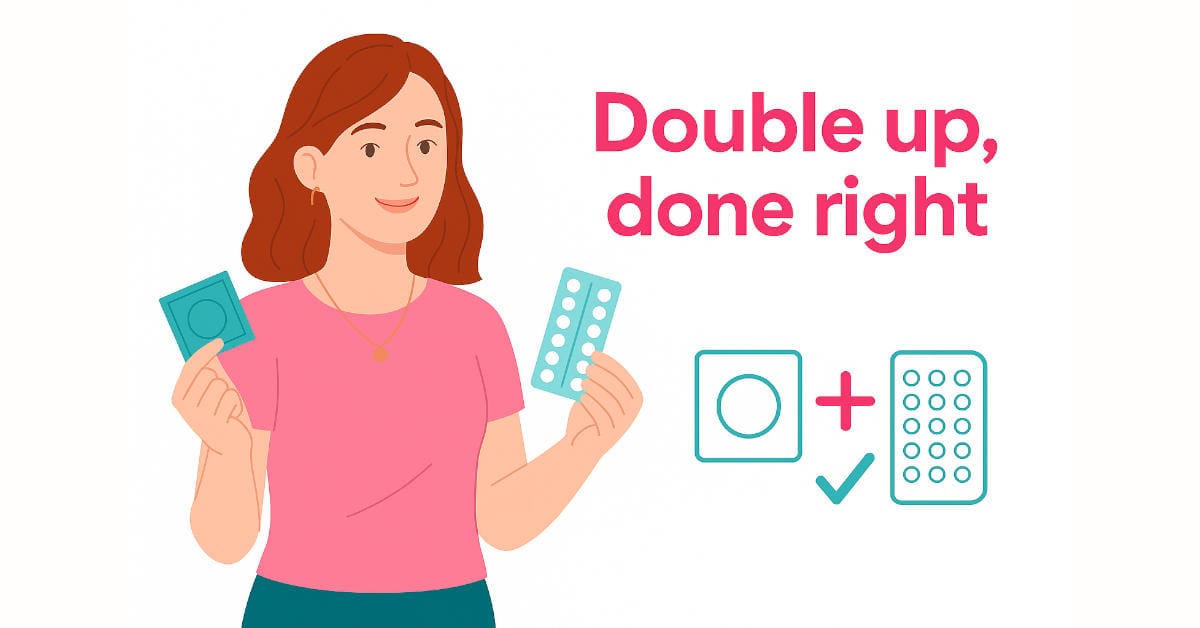Using two birth control methods at the same time can lower pregnancy risk, especially if at least one method is less dependent on perfect day to day use. The calculator below gives an approximate estimate of protection when you combine methods under typical or perfect use. It is a modelling tool, not a substitute for medical advice.
Check your combined protection
Select your methods to see their combined effectiveness.
How the estimate works (plain math)
- Convert each method’s effectiveness into a failure rate.
Example: 95% effective → 5% failure (0.05). - Multiply the failure rates for the two methods. This assumes the methods act independently, which is a simplification.
Example: 0.05 × 0.10 = 0.005. - Convert back to effectiveness:
1 − 0.005 = 0.995(99.5%).
This gives a useful ballpark for everyday decisions, based on published failure rates. Real life is more complex: methods are not always fully independent and individual risk can be higher or lower. A doctor or clinic can help you choose a method mix that fits your health and goals.
If you want a more detailed estimate that also considers age and lifestyle factors, you can try the Advanced Risk Calculator. This is still for education only and is not a replacement for professional advice.
Pairings that usually perform well
- Pill + condom: daily hormonal protection from the pill plus a barrier that also reduces many STI risks.
- IUD or implant + condom: long acting baseline protection from the IUD or implant, plus condom protection against pregnancy and STIs.
- Diaphragm + spermicide: this pair is designed to be used together and is discussed that way in guidelines.
When something goes wrong
If a condom slipped or broke, or a pill was missed during a time when pregnancy is more likely, emergency contraception may further reduce risk. Use the Emergency Contraceptive Pill Effectiveness Calculator for general information about timing and expected impact, then talk with a doctor, nurse or pharmacist as soon as you can about which option is right for you.
What to avoid and why
- Two condoms at once: higher risk of tearing because of friction between the condoms.
- External + internal condom together: the same friction problem, so they should not be used at the same time.
- Two IUDs at once: not recommended in guidelines.
- Stacking hormonal methods: can increase side effects without giving much extra benefit for most people. This should always be discussed with a clinician who knows your medical history.
For many people, one highly effective method (such as an IUD, implant, shot, pill, ring or patch) combined with condom use is enough to give very low pregnancy risk. A clinician can help you compare options, including long acting reversible contraception, and decide whether adding a second method makes sense for you.
FAQ
Does using two birth control methods make it 100% effective?
No birth control method is 100% effective. Using two methods usually lowers risk because both would need to fail at the same time, but there is still a chance of pregnancy.
Which two methods are typically most effective together?
Guidelines often highlight combinations that pair a highly effective method (such as an IUD, implant, or pill) with a condom. This usually gives strong pregnancy protection and also reduces the risk of many STIs when the condom is used every time and used correctly.
Should I use two condoms at the same time?
No. Using two external condoms together, or an external and internal condom together, can create friction that makes breakage more likely. Use one condom correctly every time instead.
Sources
- Trussell J. Contraceptive failure in the United States. Contraception. 2011. (Typical vs perfect use rates.) ScienceDirect
- CDC. U.S. Selected Practice Recommendations for Contraceptive Use, 2024. MMWR Recommendations
- WHO/Family Planning Handbook and CDC condom guidance (STI reduction; do not combine external and internal condoms): FP Handbook | CDC condoms
Educational content only, not medical advice. For personal recommendations, talk with a doctor, nurse or family planning clinic.

